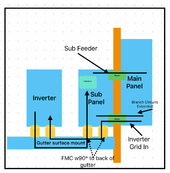Why would you use the 60C chart to size thhn for circuits less than 100 amps?
110.14(C)(1) The determination of termination provisions of equipment shall be based on 110.14(C)(1)(a) or (C)(1)(b). Unless the equipment is listed and marked otherwise, conductor ampacities shall be based on Table 310.16 as appropriately modified by 310.12.
(a) Termination provisions of equipment for circuits rated 100 amperes or less, or marked for 14AWG through 1AWG conductors, shall be used only for one of the following:
(1) Conductors rated 60C
(2) Conductors with higher temperature ratings, provided the ampacity of such conductors is based on the 60C ampacity of the conductor size used.
(3) Conductors with higher temperature ratings if the equipment is listed and identified for use with such conductors.
(4) For motors marked with design letters B, C, or D, conductors having an insulation rating of 75C or higher shall be permitted to be used, provided the ampacity of such conductors does not exceed the 75C ampacity.
So you can use the 75C chart for circuits less than 100A ONLY IF all of the terminations in the circuit are specifically rated for 75C.
This can be difficult to confirm.
In most cases, you are going to have at least one termination at an unspecified rating which forces the use of the 60C chart.
The NEC workbook shows this part of the wire sizing calculation clearly. You will notice that the 60C column in table 310.16 shows the way smaller circuits are typically wired, e.g. #14 at 15A, #12 at 20A, #10 at 30A, etc.
There is also the "tombstone rule" contained in another section.
240.4 Protection of Conductors. Conductors, other than flexible cords, flexible cables and fixture wires, shall be protected against overcurrent in accordance with their ampacities specified in 310.14, unless otherwise permitted or required in 240.4(A) through (G).
(D) Small conductors. Unless specifically permitted in 240.4(E) or (G), the overcurrent protection shall not exceed that required by (D)(1) through (D)(7) after any correction factors for ambient temperature and number of conductors have been applied.
(1) 18 AWG copper. 7 amperes
(2) 16 AWG copper. 10 amperes
(3) 14 AWG copper. 15 amperes
(5) 12 AWG copper. 20 amperes
(7) 10 AWG copper. 30 amperes
(I left out some of the extraneous listings and requirements.)
From this we can determine that NO MATTER WHAT calculations you make with section 310, you don't attach these sizes of conductors to a breaker larger than what is listed.
But, but, but what about my 14AWG extension cord? Cords are different. 14AWG cords are rated for 20A, run 14AWG wire through a conduit or raceway and it is rated for 15A. It has to do with the capacity for heat dissipation.
Table 310.12 gives the sizes for residential services and feeders, starting at #4AWG for 100A. Things can get a little confusing here, as these are calculated at a demand factor (and a lower demand factor for residential allowing smaller wire sizes). There is a situation where in a residence you could feed a 100A subpanel with #4 THHN but if you ran a 90A branch circuit for an electric furnace it would need to be #2 AWG unless the terminals at both ends were rated at 75C (in this case likely) allowing the use of #4 with the next largest breaker size rule.
I have in the past seen DIY installations where the 90C chart was used exclusively because "THHN is rated 90C." As you can probably guess, I was there because bad things happened. So I wanted to call attention to the applicable rules.
In my opinion, solar inverter output is a high current application and the wire size should never be skimped. If in doubt, use the larger size and don't forget that section 690 requires inverter output circuits to be sized at 125% of their nameplate output rating. This is instead of, not in addition to, the 120% requirement for continuous loads.



